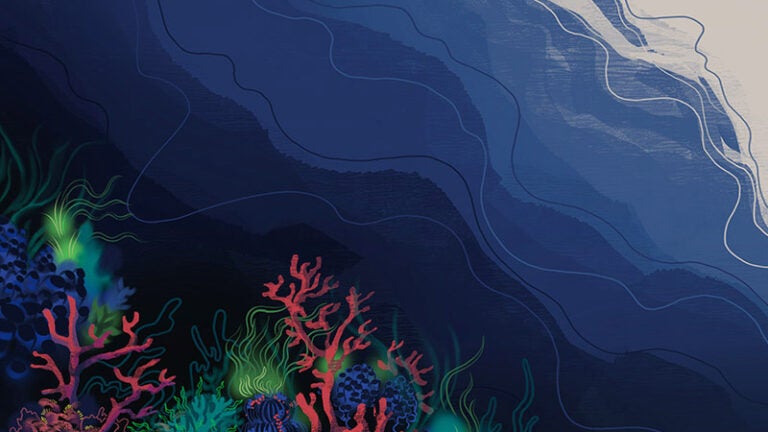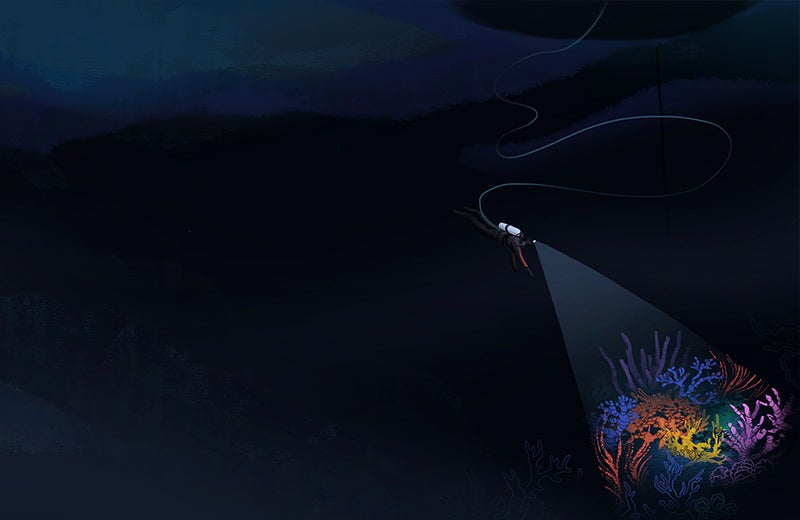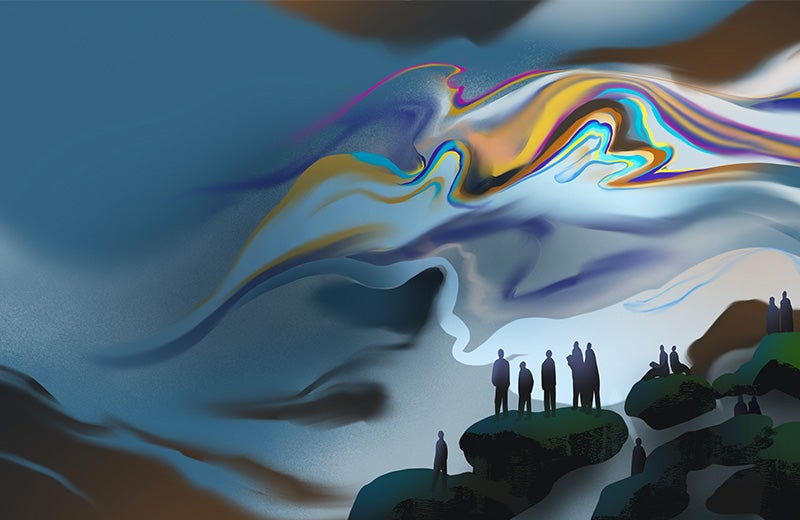
Meet the ‘water warriors’ tackling oil spills, pollution, freshwater access and other pressing challenges
Original stories by Michelle Boston, Emily Gersema, Nick Neumann, Gary Polakovic and Kathryn Royster
Water is the great primordial home; the incubator of all life on the planet. It has been and continues to be the single most important resource for all known living things.
So, it’s not surprising that water is the focal point of an array of efforts by USC Dornsife researchers, students and alumni to address some of the world’s most pressing challenges. From building resilience in farmed marine species to charting the ocean floor to ensuring homeless Angelenos get the water they need to survive, USC Dornsife scholars are finding innovative ways to quench the world’s thirst for solutions.
Stronger Mussels
In March, USC President Carol L. Folt cut the ribbon at the opening of USC Dornsife’s Nuzhdin Lab in San Pedro, California.
The lab focuses on regenerative aquaculture — the breeding, rearing and harvesting of macroalgae and shellfish — that can help produce seafood resilient to climate change. It also centers on commercializing new green technologies such as biofuels, made from kelp, that could reduce fossil fuel demand.
“Our research has the potential to reduce global warming, produce biofuels from the ocean, restore kelp populations,and provide a natural solution for the security of the California shoreline,” says Sergey Nuzhdin, professor of biological sciences.
Nuzhdin started with a handful of tanks on USC’s University Park campus in 2007. Now he has 6,000 square feet of laboratory space at AltaSea, the West Coast’s largest center for researching the development of ocean resources.
PhD student Jordan Chancellor is already working at AltaSea, growing mussels and oysters under stressful conditions to identify the genes that make them resilient to the impacts of climate change or pollution.
Researchers at the USC Wrigley Institute for Environmental Studies based at USC Dornsife may have unlocked kelp’s potential as a major biofuel source. Raising and lowering the kelp on a “kelp elevator” dramatically accelerates its growth, demonstrating the potential for mass-produced seaweed to power vehicles with biofuel harvested from the ocean.
Quenching thirst
In 2020, Catherine Cummings ’21, then a law, history and culture major at USC Dornsife, spent an afternoon handing out burritos to people experiencing homelessness in downtown Los Angeles. Frequently they also asked her for water.
Cummings learned there were few public water fountains downtown and many of the unhoused didn’t have money to buy water from stores. The COVID-19 pandemic had also closed the cafes where many had turned for a free drink.
Cummings and Kate Montanez ’20, who majored in environmental studies and political science at USC Dornsife, and Aria Cataño ’20, who majored in public policy and law at USC Price School of Public Policy, founded Water Drop LA two years ago. The organization distributes 2,000 gallons of water to the unhoused from a church parking lot each week. Hundreds of fellow USC students have volunteered for the cause, which is still going strong.
Seafood savior
Dungeness crab meat and uni, the soft innards of sea urchins, are coveted seafood delicacies. They’re also big business in California — crabbing alone brings in up to $80 million a year. Both industries are threatened by climate change.
As oceans warm, the water becomes more acidic with less oxygen. This makes it harder for crabs and urchins to form their protective shells.
“There are ocean conditions so caustic that the animals’ shells are essentially liquified as soon as they form,” says Andrew Gracey, associate professor of biological sciences.
In research funded by USC Sea Grant, based at USC Dornsife, Gracey and Nina Bednarsek of the Southern California Coastal Water Research Program are finding out how the species are impacted by these conditions at their most vulnerable point of development, the larval stage. If they can pinpoint the “tipping point” at which larvae fail to thrive, fishery managers will have more success monitoring the sea creatures’ health — and, hopefully, keeping our tables supplied with delicious and nutritious seafood.
Uncovering historic waterways
Much of the Los Angeles Basin’s original water pathways, from the once grand Los Angeles River to its seasonal arroyos, have been altered by concrete and rerouting.
In recent years, a movement to restore segments of the L.A. River to its original state, with a focus on preserving local ecology, have renewed interest in the basin’s natural ecological environment.
Researchers from a variety of institutions, including USC Dornsife, are working on a 3D map that draws from old aerial photos, indigenous knowledge and historic maps to synthesize the first complete model of the basin’s natural landscape, before urbanization.
Blue-line streams and contour lines from old maps, along with input from indigenous groups, help researchers like Beau MacDonald, a GIS project specialist at USC Dornsife’s Spatial Sciences Institute (SSI), find out where water once flowed, pooled and flooded across the basin.
“Our research can inform thoughtful restoration efforts, map potential patterns of vegetation and allow us to better understand human resource use,” says MacDonald, who is working on the project alongside fellow USC scholars John Wilson, professor of sociology, civil and environmental engineering, computer science, architecture and preventive medicine and director of SSI; Phillip Ethington, professor of history, political science and spatial sciences; and William Deverell, professor of history, spatial sciences and environmental studies and director of the Huntington-USC Institute on California and the West.
“The goal of our program is to open doors for students who otherwise may not have considered or pursued science, technology, engineering or math careers that involve scientific diving.”
Diversifying the waters
A large majority of professional divers are male and white and many are over the age of 40. A new program hosted by the Wrigley Institute for Environmental Studies, based at USC Dornsife, aims to diversify the field of diving by providing training to people from historically marginalized and underrepresented backgrounds.
This summer, program participants will head to USC Dornsife’s Wrigley Marine Science Center on Santa Catalina Island, where they will receive training, mentoring and equipment. The program is designed to help participants work toward earning an American Academy of Underwater Sciences diving certification.
“Scientific diving has a lot of barriers to entry. The goal of our program is to open doors for students who otherwise may not have considered or pursued science, technology, engineering or math careers that involve scientific diving,” says John Heidelberg, director of the Wrigley Marine Science Center and professor of biological sciences and environmental studies.
The program is funded by an Ocean Exploration Education Mini-Grant from the National Marine Sanctuary Foundation.
In uncharted territory
There’s still so much we don’t know about our planet. The ocean covers some 70% of the Earth’s surface. But more than 80% of the ocean floor remains unexplored.
In October 2021, USC Dornsife alumnus Nick Foster, an environmental studies major who minored in GIS and sustainability science, boarded the E/V Nautilus to help change that. Foster was part of a small crew that spent 10 days sailing from California to Hawaii to map a portion of the ocean floor. The group worked around the clock, processing data in pairs. On breaks, Foster would sit on the ship’s deck, rocked by the waves and looking at the stars.
The excursion was led by the Ocean Exploration Trust, a nonprofit devoted to uncovering the ocean’s mysteries. For Foster, a scuba diving enthusiast, it was the dream outcome for his educational journey.
“This experience has given me an actual physical connection to the mapping of the seafloor,” he says. “It’s something I learned about in school, and now I’m a part of it.”
Carbon Crunchers
An international team of scientists led by researchers at USC Dornsife has found that the speed of carbon transfer in the ocean — the rate at which carbon dioxide moves from the atmosphere to the water — is influenced by the size and type of bacteria that latch onto the carbon particles.
The discovery sheds greater light on how carbon — including CO2 generated by cars and other human activities — moves from the atmosphere into the ocean and ultimately makes its way into the deep ocean, says Naomi Levine, associate professor of biological sciences, quantitative and computational biology and Earth sciences.
“This is the first time that we’ve been able to build a model to predict ocean-scale carbon-cycle dynamics that account for these microscale processes that have been observed in the lab,” Levine says. “We show that the processes matter a lot.”
Healthy colonies of bacteria raise the likelihood that the carbon — released when these hungry hitchhiking bacteria munch on particles — will stay on the ocean’s surface and then return to the atmosphere.
Knowing which bacteria live in which ocean locations, and whether they’re thriving or not, could also help scientists better predict local rates of carbon transfer or release.
Cleaning House in the Harbor
Santa Catalina Island’s Avalon Harbor, 22 miles off the Southern California coast, receives upward of a million tourists each year. Visitors enjoy kayaking, paddleboarding and other water-centric activities.
What’s not allowed in the harbor? Scuba diving — with a single exception. Each year, divers flock to the bay and spend one day removing debris from the harbor during the annual Avalon Harbor Underwater Cleanup.
This year marked the event’s 40th undertaking, with USC Dornsife’s Wrigley Institute for Environmental Studies, USC Catalina Hyperbaric Chamber and Catalina Conservation Divers co-hosting.
Nearly 100 volunteers catalogued more than 2,700 pieces of debris — totaling nearly 1.7 tons — taken from the harbor by divers, according to Avalon Environmental Services.
Participants in USC Dornsife’s Scientific Diving Program were among 561 divers who also freed nearly 130 creatures that were entangled with debris, including 18 crabs, 15 sea urchins, 10 brittle stars and three octopuses, according to event officials from the Professional Association of Diving Instructors’ PADI Aware Foundation.

Spill Patrol
Early last October, the United States Coast Guard received an alarming report: An oily sheen was floating on the water off Huntington Beach, California. By the following day, tens of thousands of gallons of crude oil had spilled from an offshore pipeline in the area, contaminating the surrounding waters and much of the Orange County coastline.
As officials and conservationists scrambled to respond to the spill, they leaned heavily on data supplied by USC Dornsife’s Wrigley Institute for Environmental Studies.
The institute is part of the National Oceanic and Atmospheric Administration’s Integrated Ocean Observing System, a 24/7 monitoring program that uses radar and other sensors to track ocean currents and the color of the water along the U.S. coastline.
The Wrigley Institute maintains six of the program’s high-frequency radar installations.
“The data we get goes directly into supporting the decision-making process,” says Wrigley Institute Project Manager Matthew Ragan.
“The oil is going to be on the surface, so wherever the current is going is where the oil is going to go,” he says.
Officials use this data to decide which beaches to close and where to send boats to deploy booms, the floating barriers that corral the spilled oil.
According to Ragan, the Wrigley Institute’s radar data also delivers benefits beyond oil spill warnings. The Coast Guard uses the information in search-and-rescue operations, and the city of L.A. uses the data to help determine the safest times to perform maintenance on outfall pipes, where treated wastewater is discharged into the ocean. The information is also important for safely piloting large vessels to shore, tracking blooms of toxic marine algae that may make beachgoers and wildlife sick, and finding the source point of illegal dumping in the ocean.
“The oil is going to be on the surface, so wherever the current is going is where the oil is going to go.”
Fixated on Fixation
Nitrogen constitutes about 78% of the Earth’s atmosphere, where it exists mainly in its most stable form, a gas made of two atoms, or N2. A significant amount also resides in the oceans as dissolved nitrogen.
Most animals and plants can’t use N2. They need the nitrogen to be converted into a more biologically useful form through a process called nitrogen fixation. But only certain microorganisms can do that, and many of them live in marine environments.
The process is crucial to life on Earth, so understanding its role in the ocean and the organisms that perform it is essential, according to Doug Capone, professor of biological sciences at USC Dornsife.
“The oceans are becoming an ever-increasing source of food for humanity, and nitrogen fixation is critical in maintaining many marine food webs,” says Capone, who holds the William and Julie Wrigley Chair in Environmental Studies. His research includes studying how ocean microbes affect the movement of nitrogen through plants and animals and from land to sea to air and back.
A thorough understanding of the factors involved in nitrogen fixation in the oceans could help future generations safely and sustainably farm the seas, Capone says.
Capone co-wrote Marine Nitrogen Fixation (Springer, 2021), which summarizes the extensive research and current understanding of marine nitrogen fixation.
Primarily intended to help scientists and students as they advance the field of study, the book gives a detailed overview of topics such as which marine microorganisms are fixing nitrogen, where they live and what environmental factors — including human-caused changes such as ocean warming and acidification — affect microbial activity including nitrogen fixation.
Bequeathing Resilience
Scientists have long known that coral and algae live in mutual harmony. The coral provides algae safety and supports photosynthesis; the algae produce oxygen, help remove wastes and supply the coral with energy (as well as beautiful color).
They live together amicably — until environmental stress, such as climate change, disrupts the partnership. When this happens, some coral lose their algae and become bleached. But others are capable of “shuffling” their algae, meaning they change the environment within their cells to favor some algae over others, depending on water conditions, competition or available nutrients. Shuffling algae within their cells can help the coral cope with the changes in the surrounding water.
USC Dornsife biologists who study coral’s ability to shuffle the algae in their cells have shown that adult coral can pass along this ability to their offspring.
“What we’re finding is that corals can pass their shuffled complement of algal partners, or symbionts, to their offspring to bestow a potential survival advantage, and that’s a new discovery,” says Carly Kenkel, Gabilan Assistant Professor of Biological Sciences.
Kenkel traveled to Australia’s Great Barrier Reef and Orpheus Island as part of a team studying a particular coral, Montipora digitata, during two spawning seasons: one under normal conditions and the other during a global mass coral bleaching event.
Montipora digitata coral can package algae in their eggs when they reproduce. In looking at the eggs between the two seasons, the researchers discovered that rearrangements of the algae communities in the adults were also reflected in the coral’s eggs, indicating that they could be passed down to offspring from the parents.
The findings show coral may be more adaptable than thought, but will that be sufficient for survival?
“Corals have more mechanisms than we thought to deal with climate change, but they’re fighting with a tiny sword against a foe that’s like a tank,” Kenkel says. “Their adaptability may not be enough. They need time so they can adapt.”
Immediate Results
While traveling the world in 2008, three years after graduating with a degree in international relations from USC Dornsife, Justin Arana visited Morrungulo, Mozambique, on the southwest coast of Africa. A fateful walk accompanying a local family to collect drinking water altered the course of his travels — and his life.
After an hour on foot, the group arrived at the family’s water supply — dirty, shallow pools of water around which cows had defecated. “The experience was a stark eye-opener,” Arana says. “I was really confronted with the lack of access to clean water.”
A day later, Arana passed by the local hospital where long lines of women and children were waiting to be examined. “They couldn’t keep any supply of medicine in the hospital because people just kept coming in with ailments from unclean water,” he says.
That evening, he contacted former colleagues, describing the situation and suggesting a solution: The village needed a water well. For about $6,000, Morrungulo residents could tap into freshwater aquifers, he says. Children who previously stayed home from school to help their mothers collect water could be back in class learning. Diseases could be prevented.
The next morning, a donor came through with the funds, and before long, a new well located at the local school allowed families easy access to clean water.
“When you bring clean water to a community, you see results right away,” says Arana.
That project has since grown into Water Underground, a nonprofit that installs wells in places where they are desperately needed and helps communities learn to maintain them and distribute the water equitably, establishing self-reliance and dignity in the community.
“We have the capacity to touch people’s lives in a very powerful way,” Arana says.
“Water is a wonderful example of that.”
